-
Posts
1,635 -
Joined
-
Last visited
Content Type
Profiles
Forums
Gallery
Events
Articles
Posts posted by Drusus
-
-
Electro-Chemical Etching and a hydraulic press for this coin, the coins I am doing that are retro I hammer them. This is only my second coin, my first is this one:
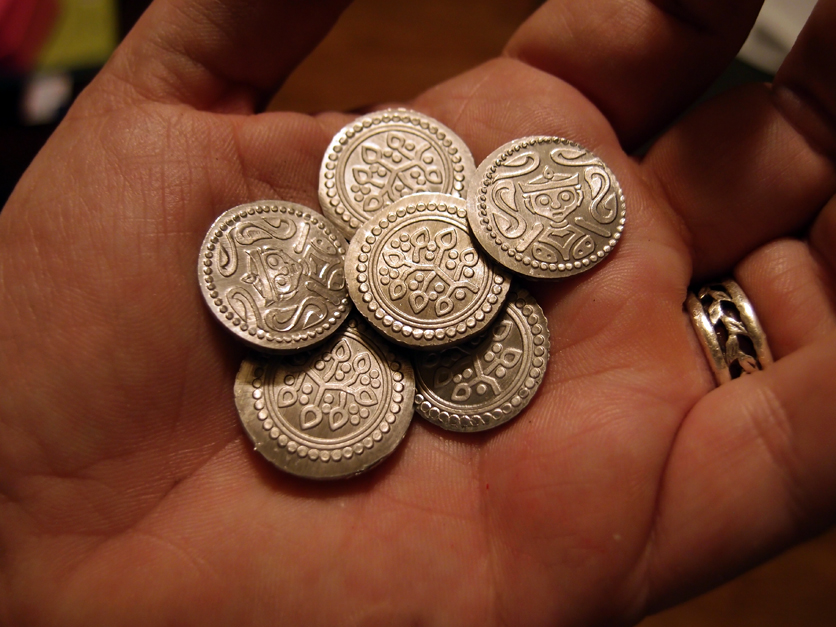
I am working on my first hand etched die but that will take some time

This coin is a merger of two 13th century German bracteate designs. The obverse being a bracteate of Duke of Bavarian Swabia Koradin minted in Schongau and the reverse represents a slightly earlier design produced by Princes Abby of Lindau showing a lime tree with seven leaves and 16 blooms, the lime tree being the Stadtwappen of the town of Lindau.
-
The coin is minted by saudi arabia 10 Halala 1972 I think?
-
Hey all,
I just finished minting my first run of Hard Times Tokens and thought I would show it. Seems appropriate for the times. This is the first strike:
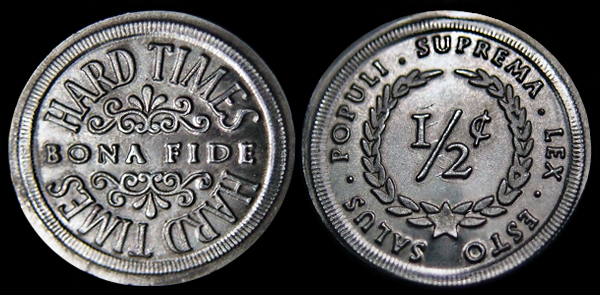
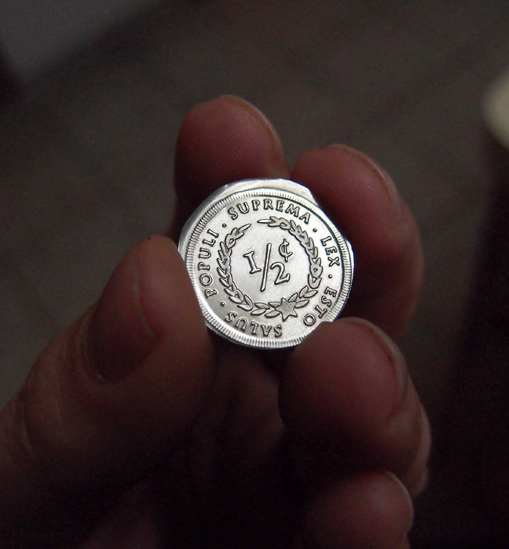
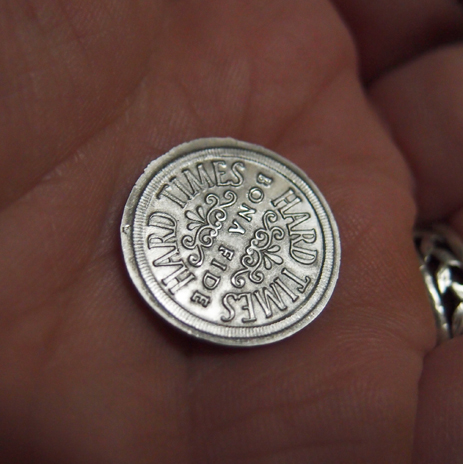
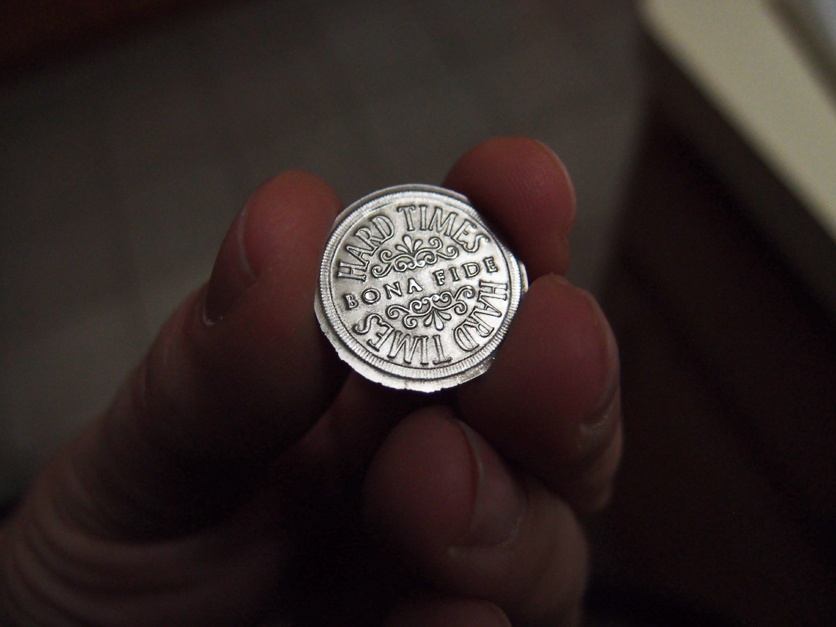
-
This is an extremely rough copy of a coronation medal for Queen Caroline...
You can see one here:
http://www.baldwin.co.uk/coronation-of-caroline-1727.html
Wouldn't fool anyone I would think.
-
These coins were billon.
Switzerland-Bern, 5 Rappen, 1826
* CANTON BERN 1826 * 5 RAP
Bern arms within circle
* DIE CONCORDIER . CANTONE DER SCHWEIZ
Cross with decorated arms and C in center within circle, flourishes in fields, all within circle
Plain edge
Billon Silver
Mintage: Unknown
KM 192
Rappens and Batzen were commonly overstuck onto earlier coins of the same type.
-
I tend to agree. I wouldn't even waste a buck on it but for those who want a reproduction coin, I see no problem with it as long as it is clearly marked and this coin is clearly marked on both sides. What people do with them once they buy them is another story. While these are cheap and unimpressive, there are some companies whose works are stunning (IMO) like Antiquanova:
-
I would like to find a genuine ancient roman aluminum coin!
That would certainly be rare

-
it is a 20th century reproduction of a Julius Caesar Denarius (mobile mint moving with Caesar from 49-48 BC.),
It is Aluminium and depicts on the obverse an Elephant facing right trampling dragon; in exergue, CAESAR, WRL punchmark on the edge.
Rev.: Pontifical emblems: Simpulum, sprinkler, axe (surmounted by a wolf's head), and priest's hat, WRL punchmark on the edge.
"WRL" means Westair Reproductions Ltd. They are based in Birmingham, UK. They sell a "Roman Coin Pack 1" and others containing this "denarius".
-
'Dictator' in the end is a somewhat subjective term as we can see from this thread...the dictionary defines a dictator as:
a person exercising absolute power, esp. a ruler who has absolute, unrestricted control in a government without hereditary succession.
So this would rule out any hereditary monarch such as Vittorio Emanuele. But it can also be a descriptive word if a person is 'like a dictator' such as dictatorial. Of course most if not all of these men did not call themselves dictator and most probably didn't think of themselves as a dictator and some may not have even planned to become one.
I compiled a biography of Mobutu and it seems Mobutu thought of himself as a father figure and his people like children and given the state of that nation when he took power, they were. I honestly think they were not ready for elections and political party's. That nation could not stop devolving into partisan violence and election results simply were not being respected. So he, as a powerful and highly respected military leader, removed the government and set up an interim government with himself as temporary president.
After a very brief rule Mobutu returned the government to civilian hands (why would he do this if he planned to take power for life?). A federalist government was implemented and the scramble for control of the nation and endless factional conflict returned. The result was four more years of political instability ending in yet another conflict between heads of state resulting in deadlock and a another breakdown of government. Mobutu, with the backing of the military, again removed the two politicians and took control of the country becoming president in 1965, this time he outlawed political parties identifying them as the root of the nations problems. He founded the MPR (the Mouvement populaire de la revolution), the only legal political party and all citizens were members. His stated goal was national unity, long term stability, and developing the nations economy.
I do believe he still planned to try another election but in the end, he was corrupted but the plain fact is, his nation was for a time better off with him in power as political parties WERE destroying that country, the people had no working government, only prolonged violence, death and misery. Does this make it right? I dont know, he certainly should have tried to give it back to the people again...his early rule was beneficial but as the years went by, it got worse and worse until he became the main problem. Sadly, once he was gone, the country went right back to the way it was before.
Mobutu was no Idi Amin (who was probably all bad) and even Bokassa, IMO, had good intentions in the beginning and once in power he built roads, outlawed female circumcision, stopped the communist infiltration of his nation which was allowed in the previous (corrupt) government, and enacted beneficial laws. Yuan Shikai did a lot of good and helped bring China and its military into the modern world, Saddam built infrastructure, allowed women a semblance of equality, and was intent on making Iraq a model of a modern middle eastern secular state. They all went bad of course but many of them were quite admirable in the beginning.
While many so called western elected democracies. republics and parliamentary monarchical states were guilty of some of the most atrocious actions, far worse than these so called dictators. What the French did to the parents of Bokassa (public execution for his father driving his mother to kill herself) and the people of the CAR, the people of Africa, SE Asia, Belgium in Africa, Britain in India and many other places...one could even say THESE nations stood as examples of the deepest cruelty in government that may have influenced those who took power once they left.
So often its not so black and white...no matter how two dimensional we would like to see things.

Western colonial enlightenment at its finest.
-
which basically brings up the problem with a thread like this, one persons hero is sometimes anothers dictator. I know people who admire Andrew Jackson....Many many people see Mao Zedong as a visionary and many others revere the Ayatollah that's why I didn't post a lot of the coins I would classify as dictators as others might not agree...The Shah of Iran was posted here but he was a monarch...if we are counting dictatorial or oppressive monarchs then this thread would last forever and would include monarchs and emperors from every nation and every time period.

I guess Yuan Shih-kai could be considered a dictator

and Chiang Kai-shek

Some would say Jomo Kenyatta was a dictator, other would say he is the father of his country...
-
Bokassa was a real winner


-
Here are a few dictators on coins I have in my collection:

Mobutu Sese Seko

Saddam Hussein (I have a few of him)

Stalin

Franco
-
both are worthy but I will make no bones about the fact I have voted for the miners peice down the line and I still think its the most impressive one from an artistic standpoint...
-
MY apologies...carry on.
-
IMO one of the best crusader coin types.
-
The portrait on the second one looks wrong.
-
I love the one you have displayed but I cant find one as cheap as I would like. I recently bought the coin with the maiden and the cow...great looking coin.
-
Thats quite a refined portrait for the time.
-
That guy was a cnut!
 Seriously though...nice coin and great write-up!
Seriously though...nice coin and great write-up! -
The obverse looks very red to me, the reverse looks roughly the right color for a coin like that with a silver coating.
-
I like the way you did the Clodius coin with the 3 images. The reflection is very slight and doesnt distract. My only critique would be one already stated, the empty space...otherwise very attractive layout.
-
Or, maybe people got the idea for a good shield design from the many UFOs floating around?

It seems so obvious now!!

-
It is a shield not a UFO...though UFO buffs will hear nothing of it:
As for the coin (it is a jeton), I think it is depicting the ancile, the sacred shield sent from the sky to King Numa by Jupiter. Please read the following from Plutarch's Lives, Volume I:
In the eighth year of Numa's reign an epidemic
raged throughout Italy, and afflicted the city of Rome. Now amidst the
general distress it is related that a brazen shield fell from heaven
into the hands of Numa. Upon this the king made an inspired speech,
which he had learned from Egeria and the Muses. The shield, he said,
came for the salvation of the city, and they must guard it, and make
eleven more like it, so that no thief could steal the one that fell from
heaven, because he could not tell which it was. Moreover the place and
the meadows round about it, where he was wont to converse with the
Muses, must be consecrated to them, and the well by which it was watered
must be pointed out as holy water to the vestal virgins, that they might
daily take some thence to purify and sprinkle their temple. The truth
of this is said to have been proved by the immediate cessation of the
plague. He bade workmen compete in imitating the shield, and, when all
others refused to attempt it, Veturius Mamurius, one of the best workmen
of the time, produced so admirable an imitation, and made all the
shields so exactly alike, that even Numa himself could not tell which
was the original. He next appointed the Salii to guard and keep them.
It was indeed OPPORTVNVS ADEST or 'here at an opportune time' as the shield saved the city from the plague.
A few shields depicted below that look similar:

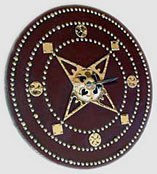
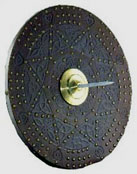
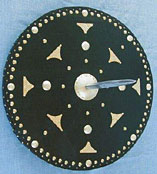
There is considerable evidence throughout the continent of Europe to show that predominantly round shields made of leather, wood, or wicker, with metal fittings and a metal boss or umbo, were being used from the time of the Bronze Age. Within the Germanic countries particularly, round or slightly oval shields with metal reinforcements were being employed. A variation was made which combined the shield with a weapon of attack: a sharp iron or bronze spike protruding from the center,
Umbo: A boss applied to the center of a shield. Usually made of iron or bronze, the umbo was in use since very early times as a reinforcement and, when appropriately designed, as an offensive device to be used at close quarters. It was generally more or less hemispherical and often supported on a ring base or truncated cone, while many old examples were integrated with a spike protruding from the center. The umbo was secured to the shield by means of metal studs, often placed so as to form decorative motifs. It was sometimes heavily ornamented, especially on parade shields, with engravings and metal laminae molded to produced elaborate designs in relief which were then silvered or gilded. By the late Middle Ages, however, the umbo was gradually disappearing from the shield, but was still occasionally used as a decorative element.
-
whatever and whom ever it is, its very nice.


Coin of unknown origin
in World Coin Forum
Posted
The issue of Price and Rainbow Tone is one for another thread...I wouldn't pay more for one but I know some would,,,if the coin is also otherwise valuable, it might fetch a slightly higher price..rainbow tone on a common penny or one in poor shape wouldn't fetch more than 1 cent I would think.